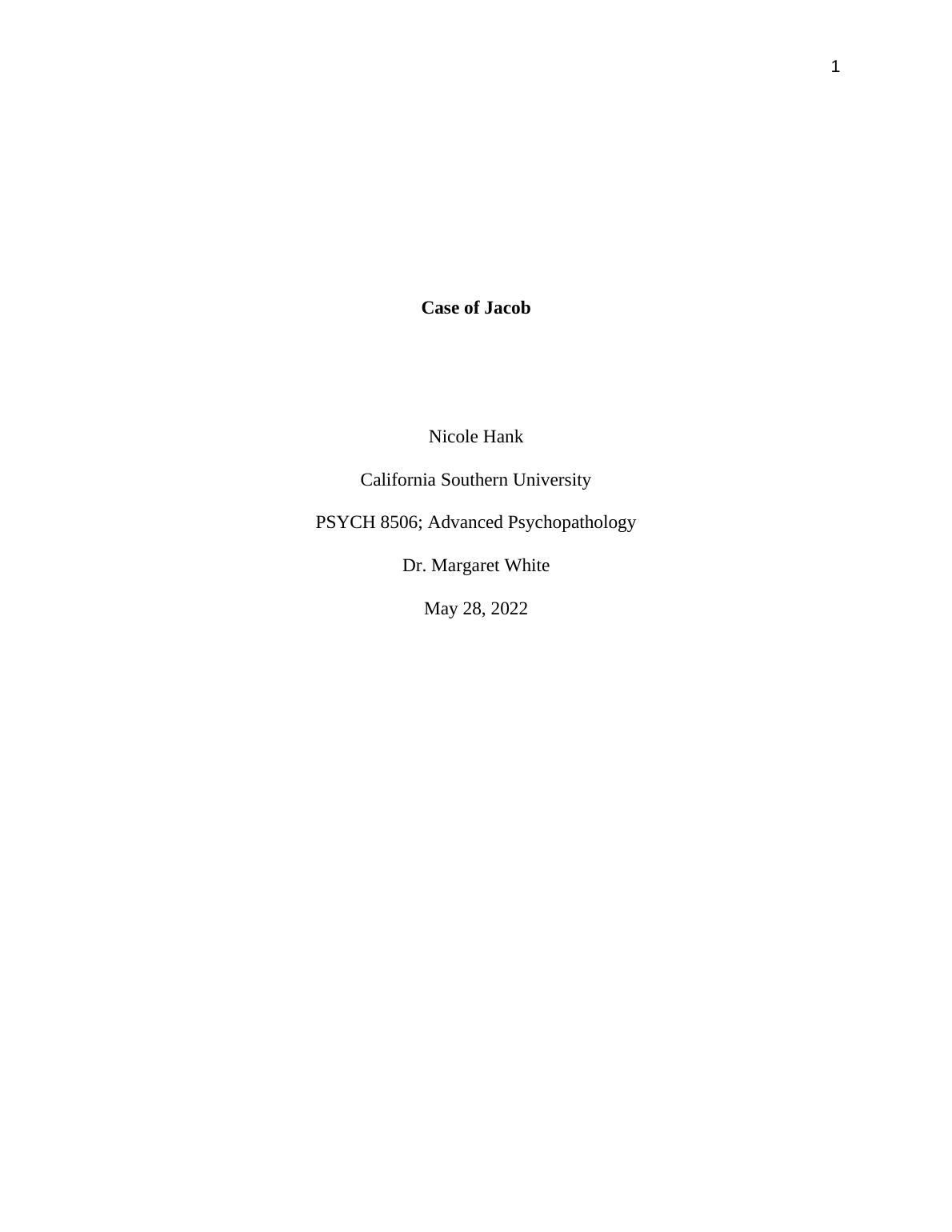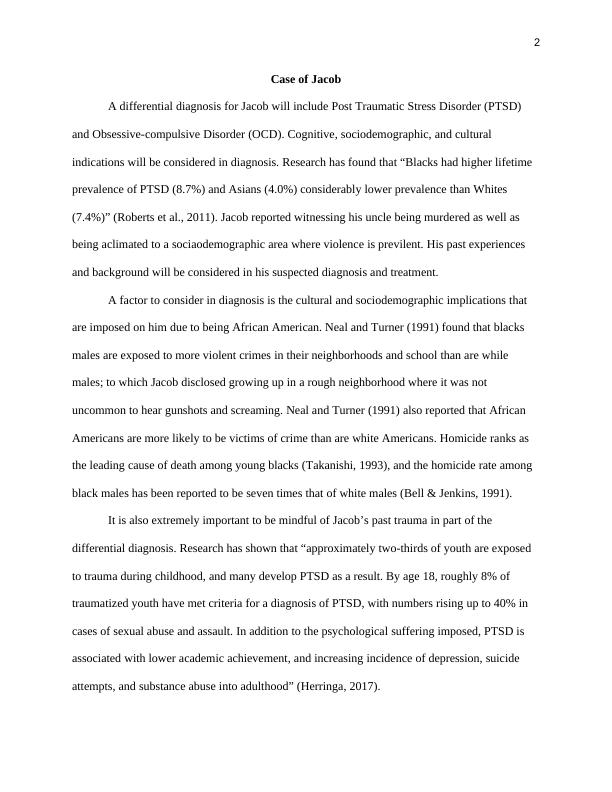Case of Jacob
7 Pages1676 Words89 Views
Added on 2023-02-02
About This Document
A case study on Jacob's differential diagnosis for Post Traumatic Stress Disorder (PTSD) and Obsessive-compulsive Disorder (OCD), considering cognitive, sociodemographic, and cultural indications.
Case of Jacob
Added on 2023-02-02
ShareRelated Documents
1
Case of Jacob
Nicole Hank
California Southern University
PSYCH 8506; Advanced Psychopathology
Dr. Margaret White
May 28, 2022
Case of Jacob
Nicole Hank
California Southern University
PSYCH 8506; Advanced Psychopathology
Dr. Margaret White
May 28, 2022

2
Case of Jacob
A differential diagnosis for Jacob will include Post Traumatic Stress Disorder (PTSD)
and Obsessive-compulsive Disorder (OCD). Cognitive, sociodemographic, and cultural
indications will be considered in diagnosis. Research has found that “Blacks had higher lifetime
prevalence of PTSD (8.7%) and Asians (4.0%) considerably lower prevalence than Whites
(7.4%)” (Roberts et al., 2011). Jacob reported witnessing his uncle being murdered as well as
being aclimated to a sociaodemographic area where violence is previlent. His past experiences
and background will be considered in his suspected diagnosis and treatment.
A factor to consider in diagnosis is the cultural and sociodemographic implications that
are imposed on him due to being African American. Neal and Turner (1991) found that blacks
males are exposed to more violent crimes in their neighborhoods and school than are while
males; to which Jacob disclosed growing up in a rough neighborhood where it was not
uncommon to hear gunshots and screaming. Neal and Turner (1991) also reported that African
Americans are more likely to be victims of crime than are white Americans. Homicide ranks as
the leading cause of death among young blacks (Takanishi, 1993), and the homicide rate among
black males has been reported to be seven times that of white males (Bell & Jenkins, 1991).
It is also extremely important to be mindful of Jacob’s past trauma in part of the
differential diagnosis. Research has shown that “approximately two-thirds of youth are exposed
to trauma during childhood, and many develop PTSD as a result. By age 18, roughly 8% of
traumatized youth have met criteria for a diagnosis of PTSD, with numbers rising up to 40% in
cases of sexual abuse and assault. In addition to the psychological suffering imposed, PTSD is
associated with lower academic achievement, and increasing incidence of depression, suicide
attempts, and substance abuse into adulthood” (Herringa, 2017).
Case of Jacob
A differential diagnosis for Jacob will include Post Traumatic Stress Disorder (PTSD)
and Obsessive-compulsive Disorder (OCD). Cognitive, sociodemographic, and cultural
indications will be considered in diagnosis. Research has found that “Blacks had higher lifetime
prevalence of PTSD (8.7%) and Asians (4.0%) considerably lower prevalence than Whites
(7.4%)” (Roberts et al., 2011). Jacob reported witnessing his uncle being murdered as well as
being aclimated to a sociaodemographic area where violence is previlent. His past experiences
and background will be considered in his suspected diagnosis and treatment.
A factor to consider in diagnosis is the cultural and sociodemographic implications that
are imposed on him due to being African American. Neal and Turner (1991) found that blacks
males are exposed to more violent crimes in their neighborhoods and school than are while
males; to which Jacob disclosed growing up in a rough neighborhood where it was not
uncommon to hear gunshots and screaming. Neal and Turner (1991) also reported that African
Americans are more likely to be victims of crime than are white Americans. Homicide ranks as
the leading cause of death among young blacks (Takanishi, 1993), and the homicide rate among
black males has been reported to be seven times that of white males (Bell & Jenkins, 1991).
It is also extremely important to be mindful of Jacob’s past trauma in part of the
differential diagnosis. Research has shown that “approximately two-thirds of youth are exposed
to trauma during childhood, and many develop PTSD as a result. By age 18, roughly 8% of
traumatized youth have met criteria for a diagnosis of PTSD, with numbers rising up to 40% in
cases of sexual abuse and assault. In addition to the psychological suffering imposed, PTSD is
associated with lower academic achievement, and increasing incidence of depression, suicide
attempts, and substance abuse into adulthood” (Herringa, 2017).

3
Gender considerations may also be considered as “the average number of traumatic
events reported by exposed men exceeds the corresponding average in women. Men with PTSD
report more impulsivity in response to emotions than women with the disorder” (Pineles, 2017).
Obsessive-Compulsive Disorder
Jacob admits to not being able to leave his house without checking that all the doors are
locked 3 times. Once he feels that the house is safe, he is hypervigilant about walking his
property to make sure that the outside is secure and safe. Further diagnostic clarification is
needed as this may be a reflection of past trauma.
Provisional Diagnosis for Jacob
Posttraumatic Stress Disorder 309.81 (F43.10) (APA, 2013).
Diagnostic Criteria
A. Exposure to actual death through direct experience, witnessing the event as it occurred to
another individual, learning that the traumatic event occurred to a family member and
experiencing repeated exposure to aversive traumatic events.
B. Recurrent distressing dreams (nightmares). Dissociative reactions (flashbacks).
C. Avoidance of external reminders (people, places, situations).
D. Negative alterations; inability to remember important aspects of the traumatic event.
E. Marked alterations in arousal and reactivity. Sleep disturbance. Irritable behavior. (“odd
behaviors”).
F. Duration of disturbance is more than 1 month.
G. Disturbance causes distress or impairment in social, occupational, or other important
areas of functioning.
Gender considerations may also be considered as “the average number of traumatic
events reported by exposed men exceeds the corresponding average in women. Men with PTSD
report more impulsivity in response to emotions than women with the disorder” (Pineles, 2017).
Obsessive-Compulsive Disorder
Jacob admits to not being able to leave his house without checking that all the doors are
locked 3 times. Once he feels that the house is safe, he is hypervigilant about walking his
property to make sure that the outside is secure and safe. Further diagnostic clarification is
needed as this may be a reflection of past trauma.
Provisional Diagnosis for Jacob
Posttraumatic Stress Disorder 309.81 (F43.10) (APA, 2013).
Diagnostic Criteria
A. Exposure to actual death through direct experience, witnessing the event as it occurred to
another individual, learning that the traumatic event occurred to a family member and
experiencing repeated exposure to aversive traumatic events.
B. Recurrent distressing dreams (nightmares). Dissociative reactions (flashbacks).
C. Avoidance of external reminders (people, places, situations).
D. Negative alterations; inability to remember important aspects of the traumatic event.
E. Marked alterations in arousal and reactivity. Sleep disturbance. Irritable behavior. (“odd
behaviors”).
F. Duration of disturbance is more than 1 month.
G. Disturbance causes distress or impairment in social, occupational, or other important
areas of functioning.

End of preview
Want to access all the pages? Upload your documents or become a member.
